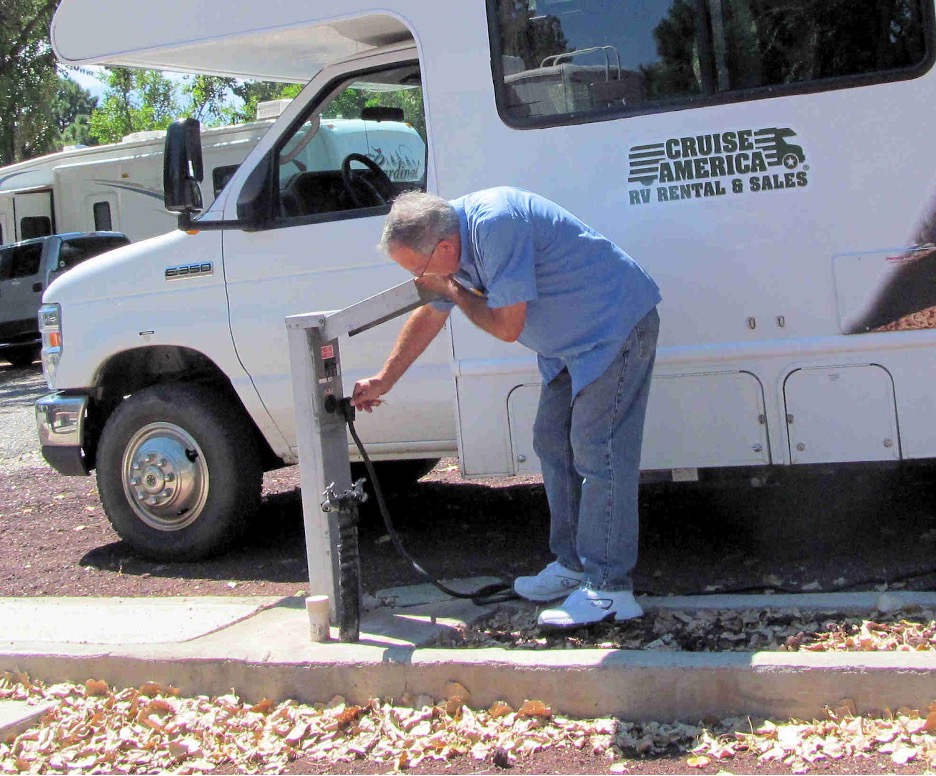
Are you a traveler but often face trouble emptying the fresh water tank of your RV?
Don’t worry. We’ve covered it all in this article.
This comprehensive guide will take you through the process of emptying the fresh water tank of the RV.
Water draining out of an RVs fresh water tank is often a nightmare, but it is a relatively simple process.
Let’s dive into the article to know more.
What Is an RV Fresh Water Tank?

RV freshwater tanks hold water used in showers, sinks, and toilets. The size of the freshwater tank comes in various sizes depending on the size of the RV, but ideally, it ranges from 20 to 100 gallons. It is typically made of seamless polythene plastic, fiberglass, or metal mounted on the frame of the RV. This stored water comes in handy at locations with limited or no access to water.
The best part of having an RV is traveling wherever and whenever you want. However, you need to fill the freshwater tank before starting the trip for daily life usage. Freshwater tanks in RVs ensure that you have ample water for drinking, cooking, cleaning dishes, toilets, and showers, and it also prevents you from constantly refilling the water on the go.
How to Empty RV Fresh Water Tanks
An RV is like a mini home built with complex engineering and has all the amenities and equipment you will need while traveling, as are its tanks. However, an RV tank is not just a bucket you can empty quickly; you need to consider many things while draining the RV’s freshwater tank.
Whether you want to empty your RVs freshwater tank to reduce its weight or prepare it for storage, this water draining guide will give you complete detail about the process.
Securely Park your RV at a Suitable Spot
It is necessary to park the RV at a safe place, specifically on a ramp, before beginning the draining process. Also, keep it at a height so there is enough space below the RV to place a container.
Switch Off the Water Heater
The second step is to switch off the water heater and wait a few hours to allow the water to cool before proceeding.
Unscrew the RV Faucets
The next step is to switch off the RVs water pump and unlatch all the RV faucets, including the shower, sinks, and outdoor showers. Also, flush the toilet; this step will remove pressure in the RVs plumbing lines.
Drain the Fresh Water Tank
Now locate the drain valve and unscrew it to empty the water in the tank. Open it steadily to prevent the water from splashing and creating a mess at the campsite. Usually, the RVs fresh water drain valve is located underneath or towards the rear of the RV.
Find the Low Point Drains
The next step is to find and unscrew the low-point drains beneath the RV to let any extra fresh water come out. These drain points are blue and red (cold and hot water) hoses.
Empty the Lines
Now, switch the RV’s water pump and unscrew all the faucets. This will remove all the remaining water in the lines to move into the gray water tank.
Check the Water Level
To ensure that the water from the freshwater tank is drained completely, you can check the water level. A transparent scale is located on the tank’s side, indicating the water level. You can also check manually by looking inside the tank.
Empty the Water Heater
To drain the RV water heater, you will need an extension, a ratchet, and a socket. Usually, a water heater plug requires a 15/16″ socket, and an anode rod requires a 1 and 1/16″ socket. Unleash the water heater plug with the socket. Lift and pressure the relief valve using one hand and remove the plug with the other hand.
Now let the water heater get empty. After the water heater gets appropriately drained, re-establish the plug and wrap it in the plumber’s tape.
Once all the water from the fresh tank, water heater, and low point drains gets empty, tighten back everything.
How Long Can Fresh Water Stay in an RV Tank?
Water gets dreadful if stored in RV water tanks for a long time. If you use your RV’s water tank sparingly, you will have to dump your water tank after every two weeks. The water stored in RV tanks for too long can lead to the growth of bacteria, algae, and mold, making water unsafe to shower, drink, and cook.
Can You Overfill a Freshwater Tank?
Most RVs have an inbuilt drain connected to the fresh water tank, which drains the excess water when it gets full. But some RVs do not have that system, and overfilling them can cause systemic damage, such as rupturing of the tank.
When to Drain RV Fresh Water Tanks
Apart from the process, it is important to know when to drain the tank. So, let’s discuss it in detail.
Before Winterizing and Storage
If you do not use your RV for three weeks or more, you must drain the freshwater tank to avoid the growth of bacteria, mold, and fungus. Also, you should empty the tank when winterizing the RV.
Before Driving
When driving your RV, normally, you should drain most of the water, considering the weight of the water can cause trouble while driving. Then, only leave enough to use for toilet purposes.
Before Sanitizing the Tank
To ensure the safety of the drinking water in the RV, it is important to sanitize the tank before use, and the primary step in sanitizing is to empty the tank.
Where To Drain Your RV Fresh Water Tank?

There are yet no rules or regulations for draining the fresh water tank of the RV as it is free from any bacteria, fungus, shampoos, germs, or harmful environmental elements. Thus, you can drain it anywhere. Also, you don’t need any pipe or hose to guide the water in a particular direction, and you can unlock the valve and keep it open for a while. However, you must follow the steps to do the process effectively.
If you use bleach to kill the bacteria in the tank, you will need to look for a safe place to empty the tank. Once you are done with the process, ensure the bleach doesn’t harm the ground. Also, rinse the tank and the ground to ensure the bleach is gone.
Conclusion
Water is essential for life and a must-have asset while on the wheels. Thus, water stored in freshwater tanks is a backup in places with less or no water supply.
However, RV is a machine that requires regular maintenance, and as an RV owner, it is vital to maintain the health of the RV system; thus, draining the fresh water tank becomes crucial.
Leaving the water in the tank for too long can cause health hazards and mechanical disparities. Follow this comprehensive step-by-step guide to drain your RVs freshwater tank without hassle.


1 thought on “How to Drain an RV Fresh Water Tank”